December 27, 2010, 11:06:00 GMT
permalink Post: 6144941
Seriously, they couldn't possibly know that the new nozzle fell short of it's design promise. There was no means of measuring thrust in flight installed on the aircraft and even if there had been the possible precision would not have allowed one to make such judgement. The only certain thing in aircraft design is weight, and that could be established unequivocably - it was lighter than the original. Any aerodynamicist looking at the two designs could tell you that the drag of the TRA (Tuyere Reverse Aval) was going to be less than that of the prototype nozzle, but establishing an exact value was another matter.
For the record. the idea of a new design originated in Sud Aviation. The development of the design was entrusted to a joint BAC/RR/Sud/Snecma team (I was one of that team, so maybe I am biased!). Snecma were not very keen on the idea of a new nozzle, largely from pride and a strong NIH factor, but one could not in fairness blame them for any performance shortfall - it was a joint effort.
CliveL
Subjects
Nozzles
Rolls Royce
Links are to this post in the relevant subject page so that this post can be seen in context.
Reply to this quoting this original post. You need to be logged in. Not available on closed threads.
December 27, 2010, 12:13:00 GMT
permalink Post: 6145017
I've pulled this quotation out at random from what I have found a rather disappointing sequence of postings. I could write reams about this (and like everyone in this thread I would write as a Concordophile), but I won't - or at least I will try not to. In general I'm with Christian on this, and for the record I think a few 'counterfactuals' should be recorded. I am not trying to reopen a sterile debate - as CJ has said irrevocable decisions have been made and the subject is done and dusted. However, let us remember that:
G-BOAF was, and is the property of BA; BAe and now AI are merely caretakers.
AI's statement cross-posted from the Heritage website strikes me as a very reasonable statement; we found that your roof is leaking, if you don't get it fixed it is going to get worse rather rapidly; if you (BA) agree and will pay us to do it we will take it indoors and fix it. I don't see any sinister intent here, and given the weather we have had in the UK over the past weeks it must be regarded as a happy, if fortuitous decision!
Those who know Filton will also know that there is nowhere that Alpha Fox could be stored under cover except in the hangar where she was first assembled. They will also know that this hangar is buried in the centre of the factory and nobody, in a post 9/11 world, is going to give more or less unrestricted public access to somewhere containing a lot of valuable real estate! So when BA took the decision to locate AF at Filton it must have been in the knowledge that she would live in British weather until some form of shelter could be organised.
That it has taken so long to (fail to) organise such shelter is regrettable, but the blame can hardly be uniquely allocated to AI. BA own the aircraft, BAe/AI had a 40% share in building the airframe, RR a 60% share in building the powerplant. IMHO they should all have chipped in to construct some sort of shelter - it was never on the cards that local enthusiasts could have raised enough in a short time.
Although 'Dude' says that all the UK airframes were left out in the weather, this is not exactly true is it? 002 at Yeovilton (certainly) and 101 at Duxford (I think) are under cover and receive lots of TLC. It is at least arguable that these early airframes have more historical significance than Alpha Fox.
So far as AI's decision to hand back the C of A is concerned, they would have already recognised from the post-Gonesse activity that most people with sufficient expertise on the Concorde design were retired (or worse!) They have enough people to keep a subsonic aircraft going, but Concorde would, I think, require additional experience. AI management would certainly have consulted AI Engineering about this, and I have to say that the then Head of Engineering was someone I know well. He, like me, worked on Concorde in the early days and he is definitely not antiConcorde. I for one would respect his decision.
So far as the decision to stop services goes, we all knew they would be cut off sometime.the only question was when. When we were designing the aircraft the general feeling was that she would stay in service for about 30 years, but we also feared that it would only need one fatal accident to bring the whole lot crashing down. [Incidentally, it was that latter philosophy that made us (we hoped) ultracareful with airworthiness issues] In the event it was 28 years and one accident.
Even before Gonesse AF were losing money on their Concorde services. One might have thought that they would stop right away, but I suspect that a combination of Gallc pride and politics ensured that they would carry on.
But eventually there came a point where, on an airline losing money and in a recession, an unsentimantal and yes, generally unsympathetic, management would have to say enough is enough.
What else would you have them do? Continue to fly loss making services so that their rival BA could go on with their profitable? operations? One would have to say 'Get real!'
Once AF had decided to stop, what do you expect of AI? They are a company with a duty to make profit for their shareholders. OK, they had a duty, also to support in service aircraft, but that duty does not extend to doing that at a loss. With AF out of it therefore AI had no alternative but to ask BA to shoulder the full bill. I have no doubt that when BA declined to do this AI breathed a huge sigh of relief, but at the end of the day the decision to stop all Concorde services was above all an AIRLINE decision.
Sorry to go rabbiting on, but it is a subject that arouses strong emotions!
CliveL
Subjects
Air France
Air France 4590
British Airways
Filton
G-BOAF
Rolls Royce
Toulouse
Links are to this post in the relevant subject page so that this post can be seen in context.
Reply to this quoting this original post. You need to be logged in. Not available on closed threads.
December 27, 2010, 14:04:00 GMT
permalink Post: 6145144
This actually is interesting in that the n umbers show one of the fundamental features that made the Ol 593 such a good choice. If you look closely at the TO and cruise values you will find that at TO the overall compressor pressure ratio is 13.5 the compressor exit temperature 460 degC and the turbine inlet temperaure is 1152 degC. In cruise the pressure ratio is 10.5, the compressor exit is 565 degC and the TET 1100 degC.
Somebody, I can't find the exact post, was asking whether the elevated cruise total temperatures affected engine life, and here we see why this is so. As Christian said in another posting, when you compress air it gets hotter - from 21 degC to 460 degC at take off and from 127 degC to 565 degC in cruise. A fundamental limit on engine operation is the turbine entry temperature. Not only does it affect the maximum TO thrust you can get but also the continued exposure to cruise TETs has a very big effect on engine fatigue life, and engine manufacturers have shown extremes of ingenuity when developing new materials and ways of cooling the blades to increase allowable TET.
The problem with supersonic operations is that you start from an elevated intake delivery temperature so that when the flow exits the compressor it is already very hot 565 instead of 460 to be exact. But the maximum temperature one can stand for fatigue reasons is limited, therefore the amount of fuel you can pour in must be limited also, and the thrust you can develop per pound of airflow is roughly proportional to the fuel input/temperature rise. To get any sensible cruise thrust then one must squeeze the cruise TET as high as you dare for fatigue reasons but also you need to keep the compression ratio down so that the temperature going into the combustion chambers is as low as you can get away with. This tend to drive engines designed for extended supersonic operations to having a low pressure ratio. This is against the trend in subsonic operations where compression ratios have been steadily increasing along with bypass ratios.
The net result then is that the engine must be designed with a low OPR and must operate with cruise TET much closer to its TO TET value than would be necessary, or indeed desirable, on a subsonic design.
I was not even aware of this A33/340 similarity, sounds yet another case of Airbus using Concorde technology. (Immitation still is the greatest form of flattery I guess). As far as I am aware Concorde had none of the lubrication issues that you describe. M2Dude
Actually, here, as on some other apparent carry-overs, one should look at the equipment supplier rather than the aircraft manufacturer to trace continuity. Here we have Messier supplying Concorde's gear and Dowty (OK they are now part of Messier) supplying the A330. And having worked on both, I seem to remember that the means of doing the shortening are quite different.
Yes, they both came out of the Bristol drawing office. One minor anecdote: the 'ramshorn' stick was a novelty to the Concorde flight test crews but they got to like it, or at least put up with it. All went well until it came to the time when Dave Davies, the ARB Chief Test Pilot, came to put his rubber stamp on the aircraft.
Concorde's seats, just like those on your car, could be moved back and fore to get your legs on the pedals and up and down so you could see over the bonnet (sorry, instrument panel). The control column of course stayed in one place, so the relationship of the 'horns' to ones thighs varied with ones height. Andre Turcat was about 6ft 2in, Trubbie and the others of average height. The smallest regular pilot was Jean Franchi at, I suppose, about 5ft 7 or 5ft 8. No problems. But Dave Davies was short like me and he found that he could not get full back stick and full aileron because the ramshorn fouled his thighs.
Consternation! Completely unacceptable! I don't know what arguments they used to convince him it was all OK really, but it got through certification. I would certainly be interested to learn from the pilots in this group as to whether it was ever a problem.
I can't resist this one!. Has anyone ever noticed/wondered about the tiny bit of the outer elevon that has been chopped off? That was my first real input into the design as a young erk looking at variability of touchdown conditions and coming to the conclusion that if the pilot got into trouble and was trying to pick up a trailing wing with too much AoA as well then he was likely to hit the ground with the downgoing elevon. I persuaded my boss that this was so and we made a small adjustment.
In self defence I am going to plead that this was well before the days of the Type 28 nozzle, so the issue of buckets contacting the ground first never came up!
To the point where an American Airline maintainance engineer, watching a prototype taking off and with full benefit of being located strategically for maximum sideline noise, remarked on what he described as 'visible acoustic radiation'
On another occasion, it was reputed that Stanley Hooker, watching a TO in the company of HRH the Duke of Edinburgh, remarked that "You know Sir that that noise represents less energy than it takes to boil an egg". to which he got the reply "Then I must congratulate you Sir Stanley, on producing so much noise for the expenditure of so little energy".
There was an effect and in consequence the aircraft performance brochures were formally calculated for north/south flight. Pity really, it would sometimes have been nice to be able to fly guarantee performance demonstrations in the most favourable direction

That's enough for today!
CliveL
Subjects
Afterburner/Re-heat
Airbus
AoA
Boeing 747
D. P. Davies
Elevons
Fatigue
Intakes
Nozzles
Olympus 593
Rolls Royce
Sir Stanley Hooker
Thrust Reversers
Visor
Links are to this post in the relevant subject page so that this post can be seen in context.
Reply to this quoting this original post. You need to be logged in. Not available on closed threads.
December 28, 2010, 07:45:00 GMT
permalink Post: 6146110
I will now SHUT UP on the subject
CliveL
Subjects: None
No recorded likes for this post (could be before pprune supported 'likes').Reply to this quoting this original post. You need to be logged in. Not available on closed threads.
January 02, 2011, 16:17:00 GMT
permalink Post: 6155241
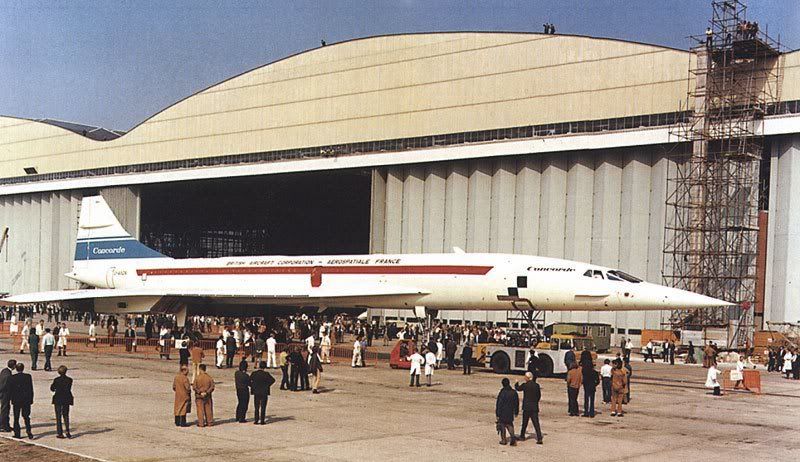
And of course a happy 2011 to all!
CliveL
Last edited by CliveL; 2nd January 2011 at 16:25 . Reason: Additional information
Subjects
Intakes
Links are to this post in the relevant subject page so that this post can be seen in context.
Reply to this quoting this original post. You need to be logged in. Not available on closed threads.
January 02, 2011, 16:28:00 GMT
permalink Post: 6155255


CliveL
Subjects
G-AXDN
Links are to this post in the relevant subject page so that this post can be seen in context.
Reply to this quoting this original post. You need to be logged in. Not available on closed threads.
January 02, 2011, 18:25:00 GMT
permalink Post: 6155422
My own humble black and white photos of 101 roll out show her with the Aerospatiale logo.
I guess from that data one could approximately date the LE photo that Christiaan posted.
Subjects
Aerospatiale
Links are to this post in the relevant subject page so that this post can be seen in context.
Reply to this quoting this original post. You need to be logged in. Not available on closed threads.
January 02, 2011, 22:30:00 GMT
permalink Post: 6155768
CliveL
Subjects
Aerospatiale
G-AXDN
Links are to this post in the relevant subject page so that this post can be seen in context.
Reply to this quoting this original post. You need to be logged in. Not available on closed threads.
January 03, 2011, 07:40:00 GMT
permalink Post: 6156208
Although it looks messy and there are parts missing (LE, nozzles and probably tail cone) none of them would take long to fit, which is why I estimated a couple of weeks before rollout, but I wouldn't quarrel with a longer time.
I knew the company merger was in 1970, but AS took a while to decide that they wanted to be known as Aerospatiale, so I thought that maybe, just maybe, this fell into that time slot. Obviously it didn't.
AZR
Your eyesight is better than mine! I had to fiddle with PSP to see it, but yes, the Aerospatiale logo is there. I was fooled by seeing the red fuselage stripe underneath into thinking that cover was more transparent than it actually was.
CliveL
Subjects
Aerospatiale
Nozzles
Links are to this post in the relevant subject page so that this post can be seen in context.
Reply to this quoting this original post. You need to be logged in. Not available on closed threads.
January 06, 2011, 19:02:00 GMT
permalink Post: 6163302
One little unique point about 102; she flew with a different intake control system to any other Concorde, being an 'improved' Ultra Electronics analog system. (Although the intake itself was aerodynamically the same as the later aircraft). Never really understood why our French friends chose this particular path with this aircraft. (Perhaps CliveL can shed some light on this??)
One of the things I like about this thread is the way in which it reminds me of things I had forgotten about the design phase - or in this case informs me of things I maybe never knew! I just do not remember any improved Ultra AICU design. So far as the French 'choice' on the matter, they probably weren't given one. Like the rear fuselage alterations referred to in another posting , it was all a matter of timing. 102 came after 101 so 102 got the lengthened rear fuselage (which was done to improve the 'area rule' distribution and gave about 2.5% drag reduction). We (BAC) were going to do the AICU development so it made sense for 101 to get the early hybrid units. [If you were cynical you might equally say that there was no way we were going to let AS have them first!].
CliveL
Subjects
AICU (Air Intake Control Computer)
Filton
Intakes
Links are to this post in the relevant subject page so that this post can be seen in context.
Reply to this quoting this original post. You need to be logged in. Not available on closed threads.
January 07, 2011, 11:06:00 GMT
permalink Post: 6164464
No. it wsn't a typo, but you may have been misled by my use of 'hybrid' by which I meant the final AICU version which most people describe as digital.It had digital law generation but analogue servo control loops. We were responsible for development of the AICU 'laws' and with Fairford being less than an hours drive from Filton it was far more convenient to do the flight testing out of Faiford so that results could be evaluated rapidly and the next day's flight test sequence planned.
CliveL
Subjects
AICU (Air Intake Control Computer)
Fairford
Filton
Links are to this post in the relevant subject page so that this post can be seen in context.
Reply to this quoting this original post. You need to be logged in. Not available on closed threads.
January 13, 2011, 11:10:00 GMT
permalink Post: 6176851
On C of A renewal test flights (what I always called the 'fun flights') we DID used to do a 'flat' acceleration to Mach 2.1 quite regularly, as part of the test regime, and the aircraft used to take things in her stride beautifully. (And the intakes themselves were totally un-phased by the zero G pushover that we did at FL630)
As usual Dude you beat me to it! I really must give up having another life

As Dude says, the 'cruise' condition was set by the aircraft specification for transatlantic range on an 85% (ISA +5) day and the chosen mach Number was 2.0 (of which more anon). This gives a Total Temperature of 400.1 deg K. [Dude, I know your pipe-smoking thermodynamicist and he was having you on - he is quite capable of memorising the square/square root of 407.6 or whatever!]
To give margins for sudden changes in ambient temperature (we had to cater for a 21 deg change in one mile) the Mmo was set at 2.04 which matches 400 degK at ISA +1. In theory then we could have flown faster than our chose Mmo at anything colder than this, but there are two limits:
1) The object is not to fly as fast as you can but to fly with minimum miles/gallon. If you have a nice cold day and enough thrust to go either faster or higher which do you choose? For best specific range you go higher every time.
2) The thing that everyone forgets is that civil aircraft have to have margins around their authorised envelope. In Concorde's case these were set principally by the intake limits and engine surge.
Dude also says quite correctly that 101 flew to 2.23M but the production aircraft was limited to 2.13M. Now you may not believe this, but 101 could fly faster than the production aircraft because she (101) leaked like a sieve!.
I doubt I will get away with that without some explanation

Once you get past a certain Mach Number the airflow into the intake is fixed. The performance (intake pressure recovery and engine face flow distortion) then depends on how this air is shared between the engine and the throat 'bleed'. This bleed was ducted over the engine as cooling air and then exhausted (in principle) throught the annulus formed between the expanding primary jet and the fixed walls of the con-di nozzle. But if you took, or tried to take, more bleed air the intake pressure recovery went up and the primary jet pipe pressure went up with it. This meant that the primary jet expanded more and squeezed the available annulus area which restricted the amount of bleed air one could take.
Obviously if there are alternative exit paths between intake and final nozzle then you can take more bleed air off and the engine face flow distortions will benefit along with the surge margin. 101 was fairly 'leaky' in this respect, particularly around the thrust reverser buckets on the original nozzle design. This meant that 101's intake distortions were lower than the production aircraft so she could fly faster without surge - at least with the first attempt at intake control 'laws'. We managed to tweak most of the margin back eventually. Engine bay leaks were good for surge margin but VERY bad news for m.p.g.!
Here are a couple of diagrams to show what I mean. the first shows the surge lines for the various aircraft variants and also the N1 limiter Dude was talking about. NB: the X-axis is LOCAL Mach Number not freestream. The difference comes from the compression of the underwing flow by the bit of the wing ahead of the intake. Mmo + 0.2 is shown
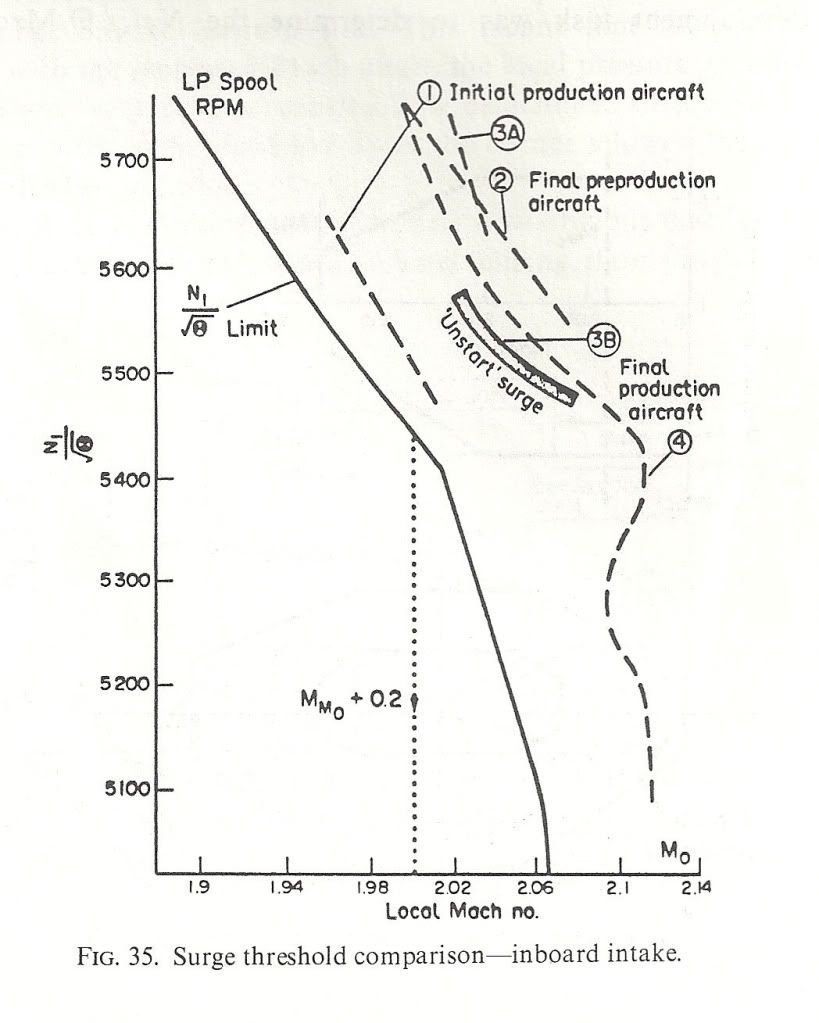 ">The next shows the surge free boundaries in sideslip and normal acceleration. You can see the zero 'g' capability Dude was enthusing over.
">The next shows the surge free boundaries in sideslip and normal acceleration. You can see the zero 'g' capability Dude was enthusing over.
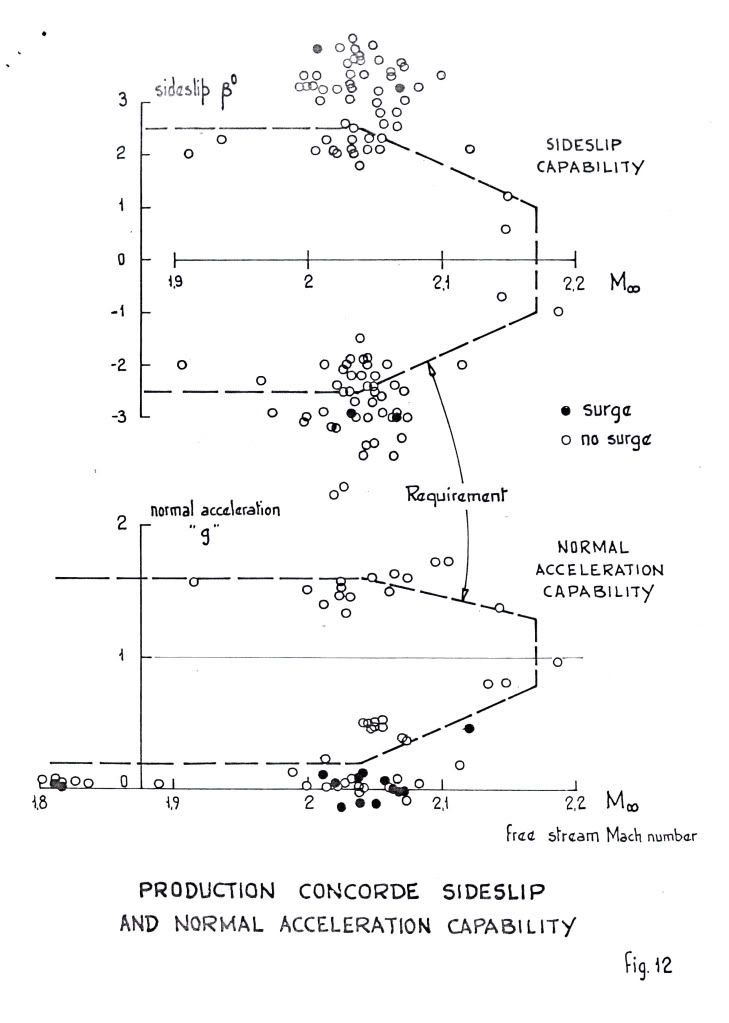 ">
">
As for 'high speed stall', I don't think we ever contemplated trying it! Our requirements in 'g' capability were defined and that was it. Besides, the aircraft would fly like the proverbial stone-built outbuilding at those sorts of conditions so I don't think one would have been able to get anywhere near a stall in the conventional sense. Stall as commonly defined for subsonics (deterrent buffet) might have been another matter, but I don't remember anything.
Cheers
Last edited by CliveL; 13th January 2011 at 11:17 . Reason: additional explanation
Subjects
AICU (Air Intake Control Computer)
Bleed Air
Engine surge
FL600
Fatigue
Intakes
Mmo
N1 (revolutions)
Nozzles
Sideslip
TMO (Temprature Max Operating)
Thrust Reversers
Links are to this post in the relevant subject page so that this post can be seen in context.
Reply to this quoting this original post. You need to be logged in. Not available on closed threads.
January 13, 2011, 20:12:00 GMT
permalink Post: 6177922
There really isn't any significant maintenance on the LE apart from de-icing mats ahead of the intake and they are all inboard of the kink
Subjects
Intakes
Links are to this post in the relevant subject page so that this post can be seen in context.
Reply to this quoting this original post. You need to be logged in. Not available on closed threads.
January 14, 2011, 08:29:00 GMT
permalink Post: 6178845
The prototype had even more 'droop' in front of the intakes, but that produced a vortex at low incidence (near zero 'g') that went down the intakes and provoked surge.
Cheers
Clive
PS: Everyone seems to be adding their favourite Concorde photograph so I thought I would be different and add my LEAST favourite

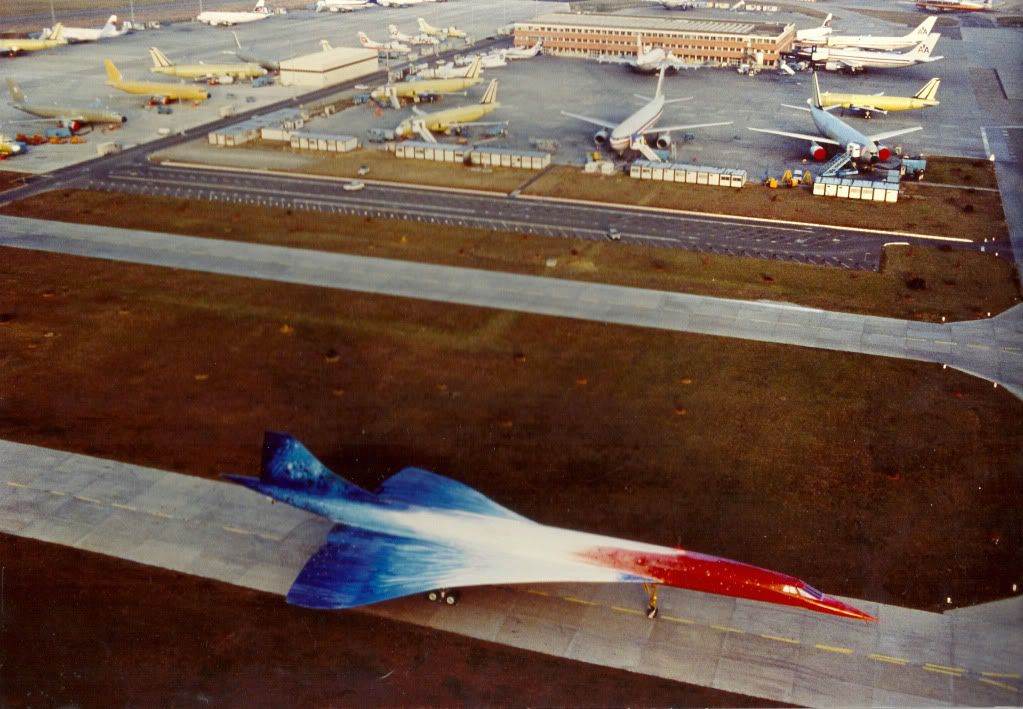 ">
">
Last edited by CliveL; 14th January 2011 at 08:43 . Reason: adding a photo and additional remarks
Subjects
C of G
Engine surge
Intakes
Trim
Vortex
Links are to this post in the relevant subject page so that this post can be seen in context.
Reply to this quoting this original post. You need to be logged in. Not available on closed threads.
January 15, 2011, 07:59:00 GMT
permalink Post: 6180649
 What
is
that Clive? It looks photoshopped to me, because why would
anyone
want Concorde to look like that?
What
is
that Clive? It looks photoshopped to me, because why would
anyone
want Concorde to look like that?

Shaggy - your serious question - the pressure at 60,000 ft is 1.04 psi and at 6000 ft it is 11.78 psi so 10.74 psi differential.
Clive
Subjects
Toulouse
Links are to this post in the relevant subject page so that this post can be seen in context.
Reply to this quoting this original post. You need to be logged in. Not available on closed threads.
January 15, 2011, 15:34:00 GMT
permalink Post: 6181348
CliveL
Subjects
Air France
Toulouse
Links are to this post in the relevant subject page so that this post can be seen in context.
Reply to this quoting this original post. You need to be logged in. Not available on closed threads.
January 16, 2011, 06:52:00 GMT
permalink Post: 6182434
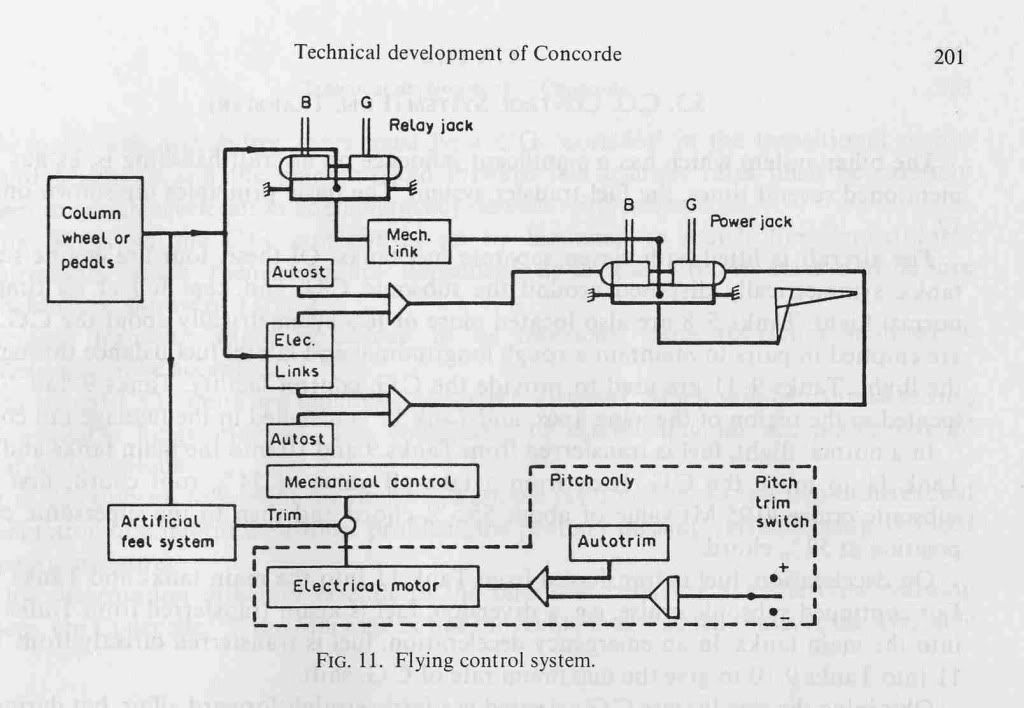
In mechanical back-up control demands were fed to relay jacks which acted as force amplifiers so the pilot was unaware of control run friction. The autopilot also fed into these relay jacks. This meant that the control precision and ability to harmonise control forces given by the electrical control system was not degraded by mechanical system shortcomings.
In electrical signalling there was a dead space at the Powered Flying Control Units (PFCU) to allow for the difference between mechanical and electrical commands produced by autostabiliser activity. Variation of this dead space with flight condition gave the autostabiliser authority limits. Autostab. was not available in mechanical signalling when the PFCU servo valve was locked to the mechanical control system.
So the control column movements were never 'ignored' by either system, but the mechanical system never 'saw' the autostabiliser commands.
Cheers
Clive
Subjects
Auto-pilot
Auto-stabilisation
PFCU (Powered Flying Control Units)
Links are to this post in the relevant subject page so that this post can be seen in context.
Reply to this quoting this original post. You need to be logged in. Not available on closed threads.
January 17, 2011, 15:14:00 GMT
permalink Post: 6185131
Cheers
CiveL
Subjects: None
No recorded likes for this post (could be before pprune supported 'likes').Reply to this quoting this original post. You need to be logged in. Not available on closed threads.
January 18, 2011, 07:50:00 GMT
permalink Post: 6186441
I spent a lot of time on this in the 80s, but really one has to assume that Sir Lancelot put the Philosopher's Stone in the Holy Grail and buried it under the (other) end of Finnegan's rainbow and that YOU KNOW WHERE TO DIG!
When I left it the project looked a lot like this photograph that Christiaan found and posted on another site:
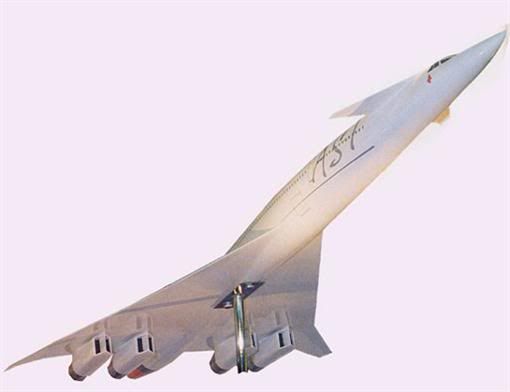
About 200 PAX, area ruled fuselage, new wing planform, flaps maybe, canard/foreplane, new shorter/lighter intake design,separate nacelles, new materials (probably not composites), digital avionics etc. but most of all a revolutionary new engine concept that nobody has invented yet. This engine has to produce lots of quiet thrust for airfield operation (low specific thrust) and lots of thrust with low frontal area for cruise (high specific thrust). Any takers?
Cheers
CL
Subjects
Avionics
Intakes
Links are to this post in the relevant subject page so that this post can be seen in context.
Reply to this quoting this original post. You need to be logged in. Not available on closed threads.
January 18, 2011, 10:08:00 GMT
permalink Post: 6186634

My reticence on using composites springs from the fact that, although it is little known, there are doubts about the life of the resins that bind the carbon fibres together when the material is exposed to a combination of high temperature and low atmospheric pressure over a long period. I know the Americans were worried about it for their 'supercruise' fighter designs and were experimenting with various exotic, expensive and obnoxious materials. Since all this was over 20 years ago and they now have their supercruise I expect they have a solution by now, but it is probably secret (I don't know that for sure however, it may well be in the public domain, I just haven't been following it). But even if they have a solution for military aircraft there is a world of difference between something that is OK for military designs with a supersonic 'life' of say 5000 hrs with a safety factor of what? 1.5? and a commercial transport with a life requirement of 50,000 hrs with a factor of 3.
BTW, if you thought the underfloor mixing unit was complex, you should have seen it in the original BAC project that didn't have electric signalling so the mechanical mixing was non-linear to try to account for varying flight condition demands

CL
Last edited by CliveL; 18th January 2011 at 10:15 . Reason: additional comments
Subjects
Super-cruise
Links are to this post in the relevant subject page so that this post can be seen in context.
Reply to this quoting this original post. You need to be logged in. Not available on closed threads.